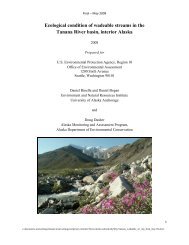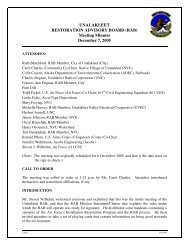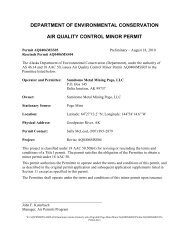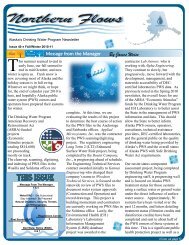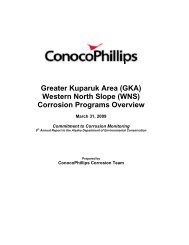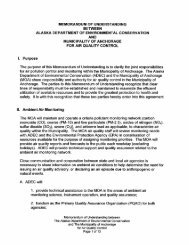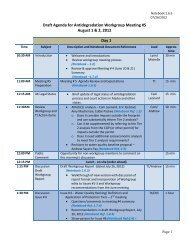2012 Ocean Ranger Guidebook Revision 3-7-12 - Alaska ...
2012 Ocean Ranger Guidebook Revision 3-7-12 - Alaska ...
2012 Ocean Ranger Guidebook Revision 3-7-12 - Alaska ...
You also want an ePaper? Increase the reach of your titles
YUMPU automatically turns print PDFs into web optimized ePapers that Google loves.
<strong>20<strong>12</strong></strong> <strong>Ocean</strong> <strong>Ranger</strong> <strong>Guidebook</strong> 3-7-<strong>12</strong><br />
(5) the capacity and location of each holding tank for graywater;<br />
(6) the capacity and location of each holding tank for combined treated sewage and<br />
graywater;<br />
Job Aid Item: 1.7.d<br />
Text: AWTS system is capable of performing IAW the vessels approved VSSP and General Permit<br />
What to check for: AWTS is operating and has no major issues that would seriously degrade the units<br />
ability to meet General Permit (and federal) wastewater limits.<br />
Background: ADEC has observed that an AWTS must be operational to meet permit and federal limits.<br />
These units are often made of individual components; the failure of one could lead to inadequately<br />
treated wastewater. For example, a failure of the UV system could allow high levels of bacteria to be<br />
discharged. If a membrane is ruptured and is continued to be used, this would allow solids and bacteria<br />
to pass through in high levels. Checks should be made if the system is operated as it regularly is during<br />
sample events.<br />
Citation: AK WW GP 1.5.5 All figures in the Effluent Limit and Discharge Reporting Tables represent<br />
maximum effluent limits unless otherwise indicated. The permittee must comply with the effluent<br />
limits at all times unless otherwise indicated, regardless of the frequency of monitoring or reporting<br />
required by other provisions of this permit.<br />
Job Aid Item: 1.7.e<br />
Text: Observe repairs, maintenance, cleaning and other operations that may affect the wastewater<br />
treatment plant effluent quality. (Example - back flush cleaning with chemicals).<br />
What to check for: Observe repairs and maintenance of the AWTS as opportunities come up. Watch for<br />
items that would degrade the performance of the system. Watch that cleaning chemicals (which can be<br />
very caustic) are handled properly and not directly discharged in <strong>Alaska</strong>n waters. Report equipment<br />
breakdowns if discharge continues.<br />
Background: Repairs, maintenance, breakdown, and cleaning are necessary to keep wastewater<br />
treatment systems functioning as designed. Failure to perform these or to incorrectly perform could<br />
lead to a failure of the treatment systems and exceedances of state and federal limits. It would be<br />
difficult to check everything, but obvious failures should be noted.These regular operations are also a<br />
good opportunity to check on ww related questions such as VSSP checks. Checks should be made if the<br />
system is operated or maintained as it regularly is during sample events.<br />
Citation: AK WW GP 1.5.5 All figures in the Effluent Limit and Discharge Reporting Tables represent<br />
maximum effluent limits unless otherwise indicated. The permittee must comply with the effluent<br />
limits at all times unless otherwise indicated, regardless of the frequency of monitoring or reporting<br />
required by other provisions of this permit.<br />
39






